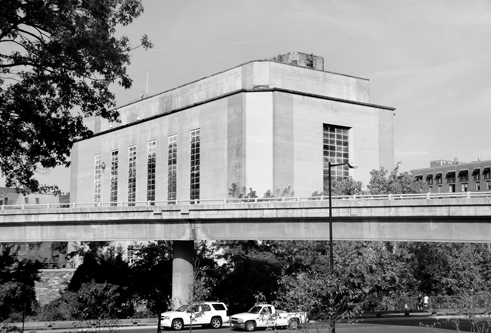Designers Detail Ideas for Heating Plant Site

By Elizabeth WienerCurrent Staff Writer
Plans to turn the grounds of Georgetown’s West Heating Plant into a park got a warm reception at a “charrette” meeting Tuesday evening. Developers of the former federal property want to use profits from converting the huge old plant on the site into condominiums to create public parkland that would connect the Georgetown Waterfront Park to Rock Creek Park.
The Levy Group and Georgetown Co., which won the right to redevelop the heating plant earlier this year, have retained landscape architect Ignacio Bunster — who also designed the popular waterfront park — to plan what is in some ways an extension to the east on the 3.6 acres surrounding the vacant heating facility.
“I love everything I’m seeing,” said one Georgetown resident who attended the charrette at Washington Harbour.
“It looks terrific,” said another neighbor.
But it’s clear that the design for the building itself is more complicated, if not more controversial. The looming 1948 structure, with its foreboding buff brick walls and art deco touches, is part of the Georgetown Historic District. Any exterior changes must pass muster with both the U.S. Commission of Fine Arts and local preservation authorities — and the Levy team is proposing big changes.
The current plan is to demolish three exterior walls — roughly 70 percent of the current building — leaving only the facade facing 29th Street. A condo building with 60 to 70 units would be rebuilt on the same footprint, but with floors inserted, banks of windows and a new ceramic coating that would echo the original color.
That’s all to be discussed at yet another community meeting, to be held Oct. 22 at the Four Seasons Hotel, which will partner with the developers to manage the luxury condo building. Richard Levy, head of the development team, said he’s optimistic the design by noted architect David Adjaye will eventually win approval.
Levy said federal preservation guidelines suggest that historic industrial buildings may need major changes to be adapted for modern use. “We’re not ones to tilt at windmills, if we did not think it was possible,” he said.
As for the park, Bunster detailed his proposal to turn unsightly hardscape into inviting green space, and to give the public access to the various historical and scenic features of what has been a fortress-like site. Various access points will allow pedestrians and bikers to enter from the Rock Creek trail, the C&O Canal and 29th Street. He described four distinct areas:
■ The “confluence,” where Rock Creek meets the canal, is on the northeast side of the site. The most important historical feature, a dry dock that served the canal, will be highlighted, with a new pedestrian bridge drawing canal visitors to the site.
■ The “creek side” is the space between the canal and the plant’s eastern wall. Another new bridge would allow hikers and bikers on the Rock Creek trail to continue around the plant to the Georgetown Waterfront Park.
■ An “elevated park,” the largest space, south of the old plant, will be transformed into a broad lawn and garden area, with a covered trellis on the west, a “playful” shallow fountain on the south, and two levels of underground parking beneath.
■ The “K Street plaza,” currently managed by the D.C. Department of Transportation, would be landscaped to improve bicycle and pedestrian access to the new park.
There would also be a broad staircase leading up from K Street to the elevated park and an elevator solely to provide access for park users.
Most questions at last night’s meeting were about security, access to the old dry dock and traffic — particularly how to keep park users safe from speeding cars on K and 29th streets. A traffic consultant said those issues will be analyzed more fully as plans for the project evolve.
The condos themselves will be “large, expensive — probably the use that will generate the least amount of traffic,” consultant Erwin Andres said.
Built in 1948 to heat federal buildings in the western part of the city, the plant has sat unused since 2000. Pressure from Congress finally led the U.S. General Services Administration to auction it off, for $19.5 million, but federal and city preservation authorities still have much say over what happens to both the building and its grounds.
All of the plans, as well as a forum for public comment, will be available on a project website in about two weeks. Levy said he doesn’t yet have a name for the website.
The developers are also inviting suggestions for naming the park.
This article appears in the Oct. 9 issue of The Georgetown Current newspaper.





